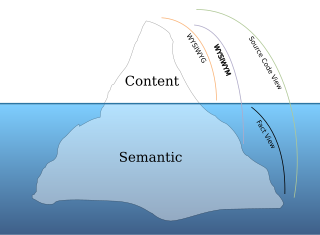
A markuplanguage is a text-encoding system consisting of a set of symbols inserted in a text document to control its structure, formatting, or the relationship between its parts. Markup is often used to control the display of the document or to enrich its content to facilitate automated processing.

In computing, What You See Is What You Mean is a paradigm for editing a structured document. It is an adjunct to the better-known WYSIWYG paradigm, which displays the result of a formatted document as it will appear on screen or in print—without showing the descriptive code underneath.
A lightweight markup language (LML), also termed a simple or humane markup language, is a markup language with simple, unobtrusive syntax. It is designed to be easy to write using any generic text editor and easy to read in its raw form. Lightweight markup languages are used in applications where it may be necessary to read the raw document as well as the final rendered output.
The following tables compare general and technical information for a number of wiki software packages.

Markdown is a lightweight markup language for creating formatted text using a plain-text editor. John Gruber created Markdown in 2004 as a markup language that is easier to read in its source code form. Markdown is widely used for blogging and instant messaging, and also used elsewhere in online forums, collaborative software, documentation pages, and readme files.

SciELO is a bibliographic database, digital library, and cooperative electronic publishing model of open access journals. SciELO was created to meet the scientific communication needs of developing countries and provides an efficient way to increase visibility and access to scientific literature. Originally established in Brazil in 1997, today there are 16 countries in the SciELO network and its journal collections: Argentina, Bolivia, Brazil, Chile, Colombia, Costa Rica, Cuba, Ecuador, Mexico, Paraguay, Peru, Portugal, South Africa, Spain, Uruguay, and Venezuela.
AsciiDoc is a human-readable document format, semantically equivalent to DocBook XML, but using plain-text mark-up conventions. AsciiDoc documents can be created using any text editor and read “as-is”, or rendered to HTML or any other format supported by a DocBook tool-chain, i.e. PDF, TeX, Unix manpages, e-books, slide presentations, etc. Common file extensions for AsciiDoc files are txt and adoc.
CiteProc is the generic name for programs that produce formatted bibliographies and citations based on the metadata of the cited objects and the formatting instructions provided by Citation Style Language (CSL) styles. The first CiteProc implementation used XSLT 2.0, but implementations have been written for other programming languages, including JavaScript, Java, Haskell, PHP, Python, Ruby and Emacs Lisp.
Doxia is a content generation framework that provides its users with powerful techniques for generating static and dynamic content. Doxia can be used in web-based publishing context to generate static sites, in addition to being incorporated into dynamic content generation systems like blogs, wikis and content management systems. Doxia is now a subproject of Apache Maven which uses it to convert APT markup documentation into HTML or other formats.
A structured document is an electronic document where some method of markup is used to identify the whole and parts of the document as having various meanings beyond their formatting. For example, a structured document might identify a certain portion as a "chapter title" rather than as "Helvetica bold 24" or "indented Courier". Such portions in general are commonly called "components" or "elements" of a document.
This is a comparison of data serialization formats, various ways to convert complex objects to sequences of bits. It does not include markup languages used exclusively as document file formats.

Org Mode is a document editing, formatting, and organizing mode, designed for notes, planning, and authoring within the free software text editor Emacs. The name is used to encompass plain text files that include simple marks to indicate levels of a hierarchy, and an editor with functions that can read the markup and manipulate hierarchy elements.

Gitit is a form of wiki software employing a distributed revision control system such as Git to manage the wiki history, and the Pandoc document conversion system to manage markup – permitting, among other things, the inclusion of LaTeX mathematical markup.

The Journal Article Tag Suite (JATS) is an XML format used to describe scientific literature published online. It is a technical standard developed by the National Information Standards Organization (NISO) and approved by the American National Standards Institute with the code Z39.96-2012.
Gollum is a wiki software using git as the back end storage mechanism, and written mostly in Ruby. It started life as the wiki system used by the GitHub web hosting system. Although the open source Gollum project and the software currently used to run GitHub wikis have diverged from one another, Gollum strives to maintain compatibility with the latter. Currently it is used by GitLab server to store and interconnect wiki-pages with wiki-links, but the plan is to move complete away from Gollum in the future.






